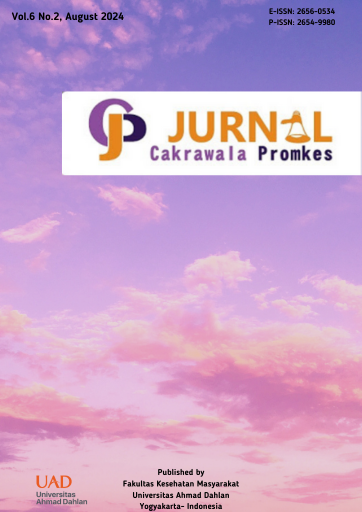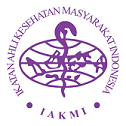The relationship between dating violence and help-seeking behavior among adolescents aged 12-14
DOI:
https://doi.org/10.12928/jcp.v6i2.10652Keywords:
Dating violence, Impact of violence, Seeking helpAbstract
Dating violence is a manifestation of inequality in any given relationship. It involves abuse within a romantic relationship that inflicts both physical and psychological harms on the victim. The psychological impacts include heartbreak, loss of self-confidence, and anxiety. This issue is particularly concerning among adolescents and warrants attention from various stakeholders. Consequently, seeking help is crucial for individuals who experience dating violence. This paper aims to assess the relationship between incidents of dating violence and the help-seeking efforts of victims. This study was a cross-sectional survey that was conducted at Junior High School. 82 respondents were recruited by utilizing relationship between dating violence and help seeking behavior was analyzed using Chi-Square. The majority of respondents who experienced dating violence reported emotional violence (25.6%) and 48.8% of these individuals did not seek help. The results indicate no significant relationship between incidents of dating violence and help seeking behavior among Adolescents aged 12–14 years old in Yogyakarta X2 (1, N = 104) = 1.7, p > .05. This suggested that, within this study, there is no significant correlation between the occurrence of dating violence and efforts made by adolescents to seek help. Despite experiencing violence, these adolescents may not be inclined to reach out for assistance, suggesting a potential disconnect between the experiencing violence and responding to it.
References
IP Sari. in dating relationships. Victim women tend to become irrational creatures by maintaining their dating relationships with consideration of the benefits in the form of avoidance. J Dimensions. 2018;7:64–85. https://doi.org/10.21831/dimensia.v7i1.21055
Parera JE, Bawole H, Taroreh H. Dating Violence Against Adolescents Viewed from a Criminal Law Perspective. Lex Cream. 2023;
Know. National Commission on Violence Against Women Annual Records. 2023;31–41.
Septiani RD. The Importance of Family Communication in Preventing Cases of Sexual Violence in Early Childhood. J Child Educator. 2021;10:50–8. https://doi.org/10.21831/jpa.v10i1.40031.
Aulia F. Descriptive Study of Help Seeking Behavior in Adolescents Who Have Experienced Parental Abuse in View of Developmental Stage (Early Childhood - Adolescence) and Gender Identity. J Ilm Mhs Univ Surabaya. 2014;3:1–17.
Dewi MO, Marsepa E. The Relationship Between Family Harmony and Juvenile Delinquency at SMP N 3 Cikupa, Tanggerang Regency, 2021. Nusant Hasana J. 2021;1:33–7.
Resdati, Hasanah R. Juvenile Delinquency as a Form of Social Pathology (Social Disease). J Cakrawala Ilm. 2021;1:91–9. https://doi.org/10.53625/jcijurnalcakrawalaindonesia.v1i3.614
Adiswanisa L, Kristiana I. The Relationship Between Secure Attachment and the Tendency to Commit Violence in Dating in Mechanical Engineering and Geological Engineering Students at Diponegoro University, Semarang. Empathy. 2014;3:128–37. https://doi.org/10.14710/empati.2014.7599
Savitri AD, Linayaningsih F, Sugiarti LR. Dating Violence in High School Students as Seen from Peer Conformity and Effectiveness of Communication in the Family. Din Sosbud [Internet]. 2015;17:41–7. Available from: https://journals.usm.ac.id/index.php/jdsb/article/view/501/303. http://dx.doi.org/10.26623/jdsb.v17i1.501
Farid MRA. Violence against Women in Unequal Power Relations: Case Study at the Rifka Annisa Women's Crisis Center. Sawwa J Stud Gend. 2019;14:175–90. https://doi.org/10.21580/sa.v14i2.4062
Triantoro. Dadi Wong Lanang: Idealization and Value Acquisition of Adolescent Boys in Java. Yogyakarta: Rifka Annisa Women's Crisis Center; 2014.
Khaninah AN, Widjanarko M. Aggressive Behavior Experienced by Victims of Dating Violence. J Psychol Undip. 2017;15:151. https://doi.org/10.14710/jpu.15.2.151-160.
Pamela A. Introduction: Feminism and Sociological Imagination”. New York: Routledge, Taylor and Francis; 2005.
Murray J. But I love Him. HarperCollins e-books; 2007.
IP Sari. Violence in Dating Relationships Among College Students: A Reflective Study of Women's Experiences. J Dimensions. 2018;7:64–85. https://doi.org/10.21831/dimensia.v7i1.21055
Sholikhah RS, Masykur AM. "In the Name of Love, I'm Willing to Get Hurt" (Phenomenological Study of Women Victims of Dating Violence). J EMPATHY. 2020;8:706–16. https://doi.org/10.14710/empathy.2019.26513.
Setiawan AD, Sanjaya EL. The Influence of Patriarchal Belief and Rejection Sensitivity on Violent Behavior in Early Adult Men's Dating. Indonesian J Guid Couns Theory Appl. 2023;12:58–69. https://doi.org/10.15294/ijgc.v12i1.62443
Murnen SK, Wright C, Kaluzny G. If “Boys Will Be Boys,” Then Will Girls Be Victims? A Meta-Analytic Review of the Research That Relates Masculine Ideology to Sexual Aggression. Sex Roles. 2002;46:359–75. https://doi.org/10.1023/A:1020488928736.
Kim J. A study of variation of control variables on adolescents' gender-role attitudes: Focusing on gender differences. Korean Journal of Youth Studies. Korean J Youth Stud. 2010;
You S, Shin K. Influence of patriarchal sex-role attitudes on perpetration of dating violence. Curr Psychol. 2022;41:943–8. https://doi.org/10.1007/s12144-020-00632-4.
Mayasari A, Rinaldi K. Dating Violence in Women (Study of Four Women Victims of Violence in Dating Relationships at University X). The Other Side of Reality. 2017;2:76–89. https://doi.org/10.25299/sisilainrealita.2017.vol2(2).2466
Santika R, Permana MZ. Exploring the Reasons Someone Dates in Emerging Adulthood. J Perceptual Psychol. 2021;6:101–12. https://doi.org/10.24176/perceptual.v6i2.6042
Nurhayati SR. Attitude and Intention to Seek Help in Facing Problems. J Hum Researcher. 2015;18. https://doi.org/10.21831/hum.v18i1.3273
Downloads
Published
Issue
Section
License
Copyright (c) 2024 Suci Musvita Ayu, Berlianna Septiyaningrum, Indah Wenerda, Septian Emma Dwi Jatmika

This work is licensed under a Creative Commons Attribution-ShareAlike 4.0 International License.
Authors who publish with JCP: Jurnal Cakrawala Promkes agree to the following terms:
- Authors retain copyright and grant the journal the right of first publication with the work simultaneously licensed under a Creative Commons Attribution License (CC BY-SA 4.0) that allows others to share the work with an acknowledgement of the work's authorship and initial publication in this journal.
- Authors are able to enter into separate, additional contractual arrangements for the non-exclusive distribution of the journal's published version of the work (e.g., post it to an institutional repository or publish it in a book), with an acknowledgement of its initial publication in this journal.
- Authors are permitted and encouraged to post their work online (e.g., in institutional repositories or on their website) prior to and during the submission process, as it can lead to productive exchanges, as well as earlier and greater citation of published work.

This work is licensed under a Creative Commons Attribution-ShareAlike 4.0 International License












